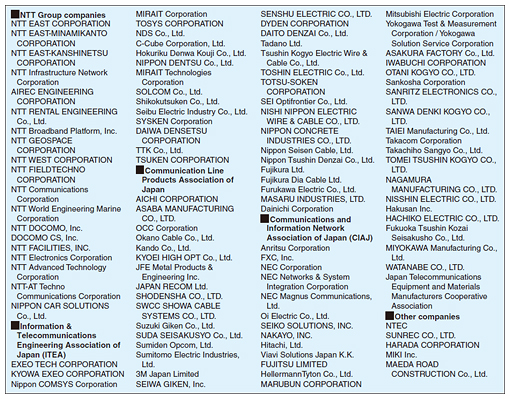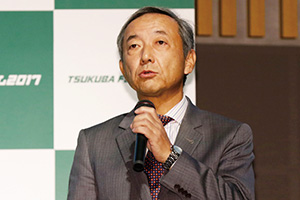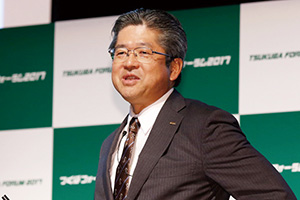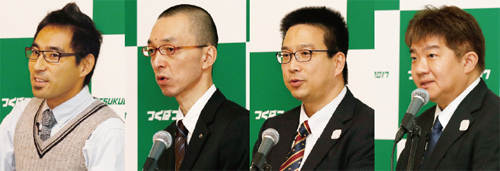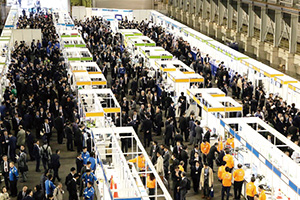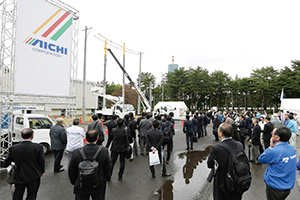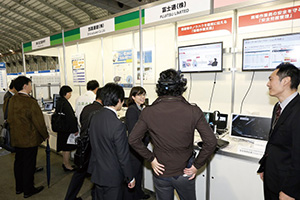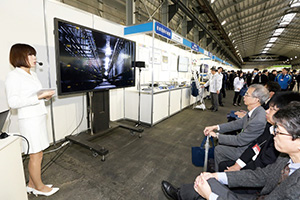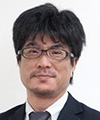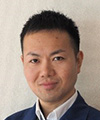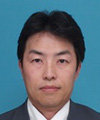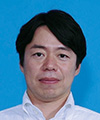 |
|||
|
|
|||
|
Information Vol. 16, No. 4, pp. 66–74, Apr. 2018. https://doi.org/10.53829/ntr201804in1 Event Report: Tsukuba Forum 2017AbstractTsukuba Forum 2017 was held on October 19 and 20. The theme of the forum was Creating Access Network Together with Essential Partners ~Advanced IoT/5G Technology and Safe Construction and Operation of Facilities. This article gives a brief overview of the speeches and exhibits presented at the forum. Keywords: Tsukuba Forum, access network, 5G, IoT, safe construction and operation 1. IntroductionThe Tsukuba Forum is Japan’s largest integrated symposium on technologies related to access networks. The 2017 event was the 28th one held since the first event in 1990. The theme of the 2017 event was Creating Access Network Together with Essential Partners ~Advanced IoT/5G* Technology and Safe Construction and Operation of Facilities. This theme expresses the desire to create an access network that leads society to sustainable development for everyone who uses the network together with those who create, maintain, and support it. In addition to NTT Access Network Service Systems Laboratories (AS Labs), 113 organizations (Table 1) participated and presented the latest research and development (R&D) and technological trends.
2. Overview of speechesThe keynote speech and a special speech were given at the Tsukuba International Congress Center on the first day. They were relayed from the main convention hall of the International Congress Center, which was the main venue, to a venue at the NTT Tsukuba R&D Center. Live streaming and video-on-demand distribution services through a video portal site were also offered. 2.1 Keynote speechMr. Yoshihiro Kuroda, Representative Member of the Board, Senior Executive Vice President and Senior Executive Manager of the Plant Headquarters from NTT WEST, gave a keynote speech entitled “Activities of the NTT WEST Group” (Photo 1). He introduced the group structure together with the roles of the NTT WEST Group companies. He also explained areas of interest, the situation with competing companies, and sales and profit information. In fiscal year (FY) 2016 (April 1, 2016–March 31, 2017), NTT WEST achieved a record operating profit of 95.1 billion yen and is aiming for 100 billion yen in FY 2017 based on three strategies: strengthening profitability in business markets, increasing the profit from fiber optic services, and expanding the business growth in each Group company.
In terms of strengthening profitability in the business market, yearly growth is expected as a major pillar of earning. The sales target is more than 600 billion yen, with over 35 billion yen in profit in FY 2017. Regarding the expansion of profit from fiber optic services, Mr. Kuroda reported that the number of subscribers of these services had reached 9 million in August 2017 and that subscriptions through a wholesale business model called Hikari Collaboration Model will be about 50% of the total number in FY 2017. Efforts are underway to expand the business growth of each Group company, and the goal was set to achieve 150 billion yen in sales through undertaking outsourced work, developing real estate, and strengthening new business endeavors in areas such as the cloud, networks, datacenters, content, and games. In addition, the activity status of the global business and the preparation status for various sports events to be scheduled in the future were introduced. Next, the state of facilities was discussed. Investments in facilities have been reduced over the years, shifting from the legacy system to growth fields. Data traffic is increasing by 1.5 times annually, and 60% of it is occupied by video traffic. Several solutions were introduced to address this situation, including simplifying networks, using a large-scale network, and implementing traffic management. In addition, in preparation for the major sports event scheduled for 2020, the NTT WEST Group is dealing with security issues in collaboration with organizations inside and outside the group. Another major management task is improving operational efficiency while promoting network migration, which will lead to cost reductions. Smart operation was also mentioned in the example of a remote technician taking the initiative to support on-site work by consolidating skills and know-how. As part of efforts to strengthen security and safety, it was announced that NTT WEST is preparing for an anticipated Nankai Trough earthquake by taking the lessons learned from the Kumamoto earthquake into consideration. New business models, namely game services, power consumption visualization, and cloud services promoted by the NTT WEST Group companies were also introduced. Activities for expanding business opportunities in cooperation with partner companies were described, using examples of the actual alliances. Through such efforts, the NTT WEST Group companies are contributing to solving various social issues. Finally, several new initiatives were introduced in the IoT and edge computing fields; trials are underway in collaboration with various partner companies. 2.2 Special speechMr. Masaaki Moribayashi, Senior Vice President, Cloud Services, NTT Communications (NTT Com), gave a special speech entitled “NTT Com’s Cloud and Data Center Strategy” (Photo 2).
The speech opened with a statement that NTT Com aims to increase the proportion of employees who work outside Japan as global activities grow, as well as to increase global business revenue from the current 27% to 40% in FY 2020. One of the strengths in promoting globalization is that NTT Com offers all resources, from networks to solutions—especially in cloud colocation networks at the global level—and can provide integrated services. With regard to datacenter business, it was stated that the submarine cable network and datacenters are designed and provided in a unified way, and that great effort is made to thoroughly pursue reliability and performance. The Hong Kong Financial Data Center was cited as an example, where the cable landing station and the datacenter are integrated. In the past, carriers have invested in submarine cables for the ever-increasing Internet traffic, but it was recently revealed that a large amount of the investment comes from over-the-top (OTT) service operators. Furthermore, while Internet traffic was once concentrated in the United States, it is now concentrated in Asia. NTT Com’s datacenters were mainly located in Japan in 2013. However, the locations outside Japan now account for about 70% of the total size, and thus, the annual capacity growth ratio of the company’s datacenters is number one in the world. Mr. Moribayashi then announced NTT Com’s plans to connect the company’s datacenters operating throughout the world with a closed 10-Gbit/s network and to provide services while connecting not only to its own company but also to other companies’ cloud facilities. As for the cloud service business, it was noted that private clouds are dominant in the domestic services and that NTT Com aims to provide private clouds for enterprises and a hybrid type cloud that combines the good points of both private and public cloud services. It was also explained how seamless service can be provided by setting a cloud and a network for each site and by managing customers’ ICT (information and communication technology) environments while reducing operational costs by applying unified management to multiple clouds. Lastly, two examples of collaboration with partner companies were introduced, namely, technology developed with McLaren-Honda and the enterprise resources planning service developed with Virtustream Inc. 2.3 WorkshopsA series of workshops was held in the afternoon of the first day and on the second day. They included lectures given by an analyst from IDATE DigiWorld and by three project managers from NTT Network Innovation Laboratories and AS Labs (Photo 3).
(1) Workshop 1 Mr. Soichi Nakajima, Digital Telco Lead Analyst from IDATE DigiWorld, gave a lecture entitled “The State of the World OTT Markets Today and Scenarios for the Digital Economy 2025.” He first explained the market size of OTT services throughout the world. The OTT market accounted for only one-tenth of the telecommunications market in 2010, but with its annual growth rate of 11.4%, it is expected to account for half of the telecommunications market in 2020. A revenue analysis of OTT operators indicated that cloud services make up a large part of the charging model, while search engines account for the major part in the advertising revenue model. However, the revenue from advertising automation is growing. In addition, Mr. Nakajima showed that competition in the OTT market has been decreasing as a result of the oligopoly structure. He also explained the different strategies of the representative players such as Google and Facebook. Next, four scenarios were introduced as economic phenomena of the next ten years, centered on whether the intensity of personal data usage and the openness of technology & data are expected to be high or low. It was predicted that the future market will be different according to each scenario. The four scenarios are as follows: 1) Club scenario: high intensity of personal data usage and low openness of technology & data, just like the current service image of Amazon. 2) Tech scenario: high intensity of personal data usage and high openness of technology & data, just like the current service image of bitcoin. 3) Low cost scenario: low intensity of personal data usage and high openness of technology & data, just like the current service image of Uber. 4) Shield scenario: low intensity of personal data usage and low openness of technology & data, just like the current service image of Apple. (2) Workshop 2 Mr. Shuichi Yoshino, Executive Research Engineer, Senior Manager of Research Planning Section/Wireless Systems Innovation Laboratory from NTT Network Innovation Laboratories, gave a lecture entitled “IoT Initiative at NTT Labs. to Create Value in Various Fields.” He introduced the requirements and functional architecture of the IoT and explained that information communication will enter the “autonomous and real-time” era in which social and industrial activities will be controlled and advanced through IoT-based networking in various fields such as healthcare, manufacturing, and agriculture. In addition to technical requirements such as real-time property and security, he said that non-technical requirements such as the establishment of a social consensus on data use, usage in the medium term, and business development will be necessary for the IoT. Next, three technologies for the IoT were introduced using case studies: 1) Sense, Connect & Drive: This features examples of technology that contribute to improving safety by analyzing and visualizing biological information utilizing “hitoe,” vehicle information, and environmental information, and instantaneous high-resolution data transfer technologies for moving obstacles and other things using a millimeter-wave band high-speed radio communication system. 2) Data & Software Logistics: This features examples of implementation in the manufacturing industry and automated driving support using the merits of edge computing, and promotion of commonalities in the interfaces of various kinds of collected data based on oneM2M specifications as IoT data-exchanging technology. 3) Analytics & Prediction: This focuses on development of person-tracking technology by establishing image analysis technology using deep learning, as well as technology to process it at high speed, and R&D of anomaly detection technology to automatically detect attacks on systems and networks connected with various devices by monitoring the behavior of networks and devices. (3) Workshop 3 Mr. Hiroyuki Nakamura, Senior Research Engineer, Supervisor of Wireless Access Systems Project/Wireless Entrance Systems Project from AS Labs, gave a lecture entitled “Wireless Access Technologies to Provide Various Services in Future Networks.” He first stated that the social background has evolved from wired to mobile and has changed to a mobile-centered lifestyle, and he showed an image of a network meeting the requirements of an access network in the IoT/5G era. He also described some contributions made to the development of wireless systems for the telecommunications business and the efforts of the AS Labs towards the era of full-scale deployment of 5G. The main issues with wireless systems for the telecommunications business were defined as improving maintainability and operation, reducing equipment costs, and system utilization. The efforts made in using satellite communications systems and terrestrial radio systems to offer telephone services in mountainous areas and on remote islands and to provide essential services in the event of a disaster were also described. Next, Mr. Nakamura explained the future of wireless access in the 5G/5G+ era, which is focused on integration of cellular/unlicensed bands, along with five key technologies: 1) unlicensed band/cellular linking technology, 2) high-capacity radio relay technology, 3) unlicensed band radio access communication technology, 4) technology to model propagation of radio waves spanning frequencies, and 5) radio environment information platform technology. Some trials in an actual environment and examples of initiatives were also mentioned. (4) Workshop 4 Dr. Atsushi Nobiki, Executive Research Engineer, Access Media Project from AS Labs, gave a lecture on the latest R&D trends in optical fiber and cable technology. He outlined optical fiber technology over the past 40 years and showed that the research theme has shifted from backbone network technology to access network technology. He explained that in the environment surrounding optical communications in Japan, the future direction of optical fiber and cable technology is to maintain and operate a huge number of optical communication facilities with fewer personnel. It is therefore necessary to improve the operational process of existing facilities (operational innovation) and to enhance operability by deploying highly functional facilities (facility renovation). For operational innovation, it is necessary to perform 1) remote maintenance, 2) automatic inspection and analysis, 3) proactive maintenance, and 4) efficient field work with skill-free tools (one-man operation). For facility renovation, it is necessary to apply 5) optical fiber technology for extra-large capacity transmission and 6) network function redeployment. Additionally, specific technologies were introduced as recent R&D topics. 3. Overview of exhibitsIn addition to exhibits from AS Labs, exhibits on the latest technologies of the co-hosting organizations and the NTT Group companies were held (Photos 4 and 5). As a first attempt at the forum, we held a joint exhibit on safety technology aimed at eliminating injuries at facility construction and operation sites. This exhibit was held in the special exhibition zone II (Photo 6).
3.1 AS LabsThe exhibition area was divided into five zones in which a wide range of R&D results of AS Labs were exhibited (Fig. 1). Information on recommended exhibits was displayed to visitors in an easy-to-understand manner (Photo 7).
(1) Special exhibition zone I Special exhibition zone I featured advanced loT/5G technologies. We exhibited cutting-edge efforts related to wired and wireless flexible access infrastructure technologies that support rich living for the IoT/5G era. Recommended exhibits in this zone were network technology for the IoT/5G era, P-MP (point-to-multipoint) wireless entrance systems with massive MIMO (multiple-input multiple-output), optical networking technologies for 5G mobile networks, the elastic lambda aggregation network, a cooperative wireless LAN (local area network) technique using a distributed smart antenna system, and 920-MHz-band wireless technology for underground infrastructure monitoring. (2) Special exhibition zone II Special exhibition zone II featured safe facility construction and operation. In this zone, we exhibited the latest technology and the evolutionary direction of facility construction and operation for improved safety by the co-hosting organizations, NTT Group companies, and NTT laboratories. Recommended exhibits in this zone were those centered on safe construction and operation, IoT technology to drastically reform construction work, optical fiber sensing of conduits attached to a bridge, advanced optical sensing technology for remote visualization of outside plants, technology for optimizing the inspection cycle of manhole covers, technology for inspecting manholes without entering them, promotion of the use of long-life conduits attached to a bridge, ideas for innovating maintenance activities, and a hydrogen embrittlement susceptibility test for rebar in concrete poles. (3) Zone I The topic of this zone was facility renovation; technologies that economically customize and bring maximum value to existing facilities were exhibited. In particular, we introduced a wireless system for disaster recovery, space-division multiplexing based optical fiber technology for realizing ultra-large capacity optical communication, the flexible access system architecture called FASA designed to meet various demands, and reach and split ratio expansion technologies using digital signal processing in optical access networks. (4) Zone II The theme in this zone was operation innovations; the exhibits featured innovative technology to drastically improve the maintenance and operation of in-house and outdoor facilities. In particular, user interface augmentation technology, unified network management technology, and new manhole covers were some of the recommended exhibits. (5) Zone III In this zone, an overall picture of the access network technologies was displayed as a model network from inside the NTT central office to a customer’s premises in an easy-to-understand way with actual equipment. 3.2 Information & Telecommunications Engineering Association of Japan (ITEA)ITEA’s efforts to promote secure, safe, and reliable information communication infrastructure facilities were presented. These efforts include maintaining the technology and know-how that have been cultivated up to now; building, maintaining, and improving the quality and efficiency of optical access networks; and promptly restoring facilities in the event of a major disaster. 3.3 Communication Line Products Association of JapanThe latest efforts and technologies of all the member companies were displayed. The technologies were related to offices and datacenters, safety and workability, as well as outdoor facilities, including optical and metal cables, connectors, and related components. 3.4 Communications and Information Network Association of Japan (CIAJ)Together with the Japan Industrial Association for Telecommunications Equipment and Materials (Zentsukyo), exhibitors who belong to CIAJ presented various products and solutions related to communication networks to achieve a safe, secure, and prosperous society. 3.5 NTT Group companiesTo provide the best and most trusted services as a value partner, the NTT Group companies displayed the latest technologies that can contribute to solving the social issues through development of new businesses and services with partner companies. 3.6 Demonstrations and technical seminarsDemonstrations and technical seminars by exhibitors were held at the AS Labs main venue and in the outdoor venue, with many participants in attendance (Photo 8).
3.7 Stamp rallyA digital stamp rally using smartphones was carried out to allow visitors to navigate throughout the exhibition hall of AS Labs. Those who gathered the eight-stamp set in the venue were awarded an original utility pole number tag. When we gave the souvenirs to the participants, we received comments such as “I got a chance to see exhibitions that I would not normally visit” and “I gained a wide range of information.” 4. ConclusionDespite the unfortunate rain, about 9700 people attended the event. We welcomed many customers from overseas and successfully held a forum. We received high interest in various exhibitions, including the latest R&D and future trends of AS Labs. Visitor questionnaires were distributed, and the results indicated that 97% of customers achieved the purpose of their visit. With the participating corporations including the co-hosting organizations, Tsukuba Forum 2017 was a successful event and a place to share innovations of access networks through exhibition of advanced technologies aiming at the IoT/5G era and R&D achievements aimed at solving issues of network operation. AcknowledgmentsWe thank the Information & Telecommunications Engineering Association of Japan, the Communication Line Products Association of Japan, and the Communications and Information Network Association of Japan for their support of Tsukuba Forum 2017. Trademark notesAll brand names, product names, and company names that appear in this article are trademarks or registered trademarks of their respective owners. |
|||









